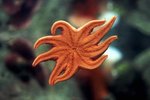
There are six existing species of sea lion, all of which belong to the pinniped family. They live in the Pacific Ocean, along coastlines and around islands. Although all six species have some differences, their adaptations for catching prey are the same.
Nostrils and Ears
Despite spending a lot of time in the water, sea lions are mammals so they can't breathe underwater and need to come up for air. In order to maximise the amount of time they can spend underwater, hunting for prey, they have special adaptations to their nostrils and ears. They're able to seal them up, so that no water can get in, which helps them to spend up to 20 minutes underwater at a time, giving them extra time to catch dinner.
Whiskers
Sea lions have evolved useful adaptations to their whiskers, which helps them seek out their prey. When underwater, visibility can be very poor, but these creatures have a way around that. Their whiskers are extremely sensitive and rotate around in the currents. When a prey species swims nearby, sea lions are able to sense it with their whiskers, then quickly locate and devour it.
Body
Shaped almost like a torpedo, sea lions' bodies are perfectly streamlined, which helps them zip through the water with ease. They can swim at speeds of up to 18 miles an hour, making it easier for them to catch even the speediest of prey. Their bodies also have a thick layer of fat -- or blubber -- that keeps them warm in the cold water. Without this insulation, they wouldn't be able to spend as long in the water, thus would find it harder to catch enough prey.
Teeth
Sea lions have between 34 and 38 teeth -- including large, conical canine teeth -- that are used to catch, tear and hold onto their prey when needed. Despite having these, the majority of their prey -- such as squid and fish -- they simply swallow whole, without even chewing first. They utilize their flat back teeth to crush the shells of crustaceans and shellfish before swallowing them.
References
Photo Credits
-
Jupiterimages/Photos.com/Getty Images




